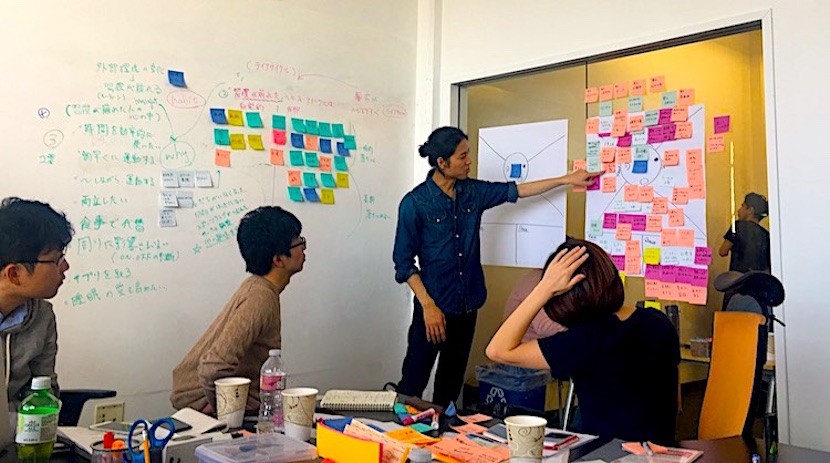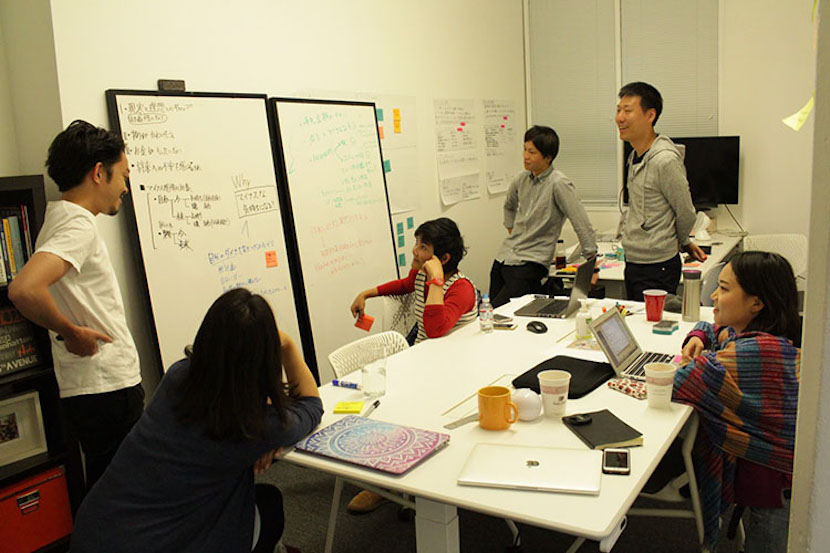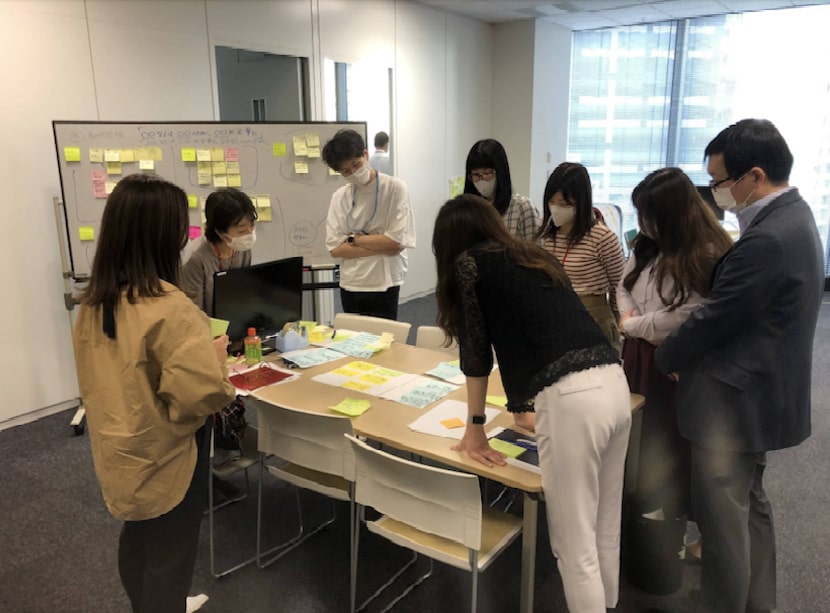
Btrax Design Company > Freshtrax > How to have an ...
How to have an effective discussion with Japanese people
Original: 日本人は議論が苦手?デザイン思考を成功に導くファシリテーションとは written by Yu Namie
In recent years, the skill of “facilitation” has begun to attract attention. This is probably due to the fact that the value of “team design,” in which teams work together to create things in order to address diverse values and a complex and unpredictable society, has become widespread.
The concept of design thinking, in which essential issues are defined and solved through dialogue with many people, encompasses the rules and processes that facilitate this kind of “team design.”
There are many people who would like to lead their company’s projects based on Design Thinking principles, but are having trouble achieving the results they want. Just to be clear, this is something that can happen even if design thinking is utilized.
This is because in order to succeed in “team design”, the skill of “facilitation” is necessary to support “creative discussion”, which is important in design thinking practice.
In this article, the author, who has been facilitating design workshops, mainly for Japanese companies, will share the value of facilitation and the tips she has learned through many failures and guidance from her seniors.
What is a Facilitator?
What do you think of when you hear the word “facilitator”? Probably, you think of someone leading a meeting or workshop.
“Facilitation is the process of helping group activities such as meetings and projects to run smoothly and produce results.”
In other words, “facilitators” are different from mere moderators. They lead discussions in workshops and meetings, and bring the team’s discussions together and lead them to an output, while maximizing the power of each person in the team.
In an orchestra, a facilitator plays the role of a “conductor.”
In particular, the presence of a facilitator is indispensable for a team to have a “creative discussion” to create something new with design thinking as the core.
In reality, however, not many people use the title of “facilitator”. In the San Francisco design community, service designers and UX designers often take on this role, and it is seen as an important skill.
The Value Facilitators Provide
Many challenges exist when facilitating discussions that will reflect a team’s strengths to reach a good conclusion.
For example, no matter how sharp an idea a member may have, he or she may not speak up enough causing a good idea to go unnoticed or they may be disregarded due to power relations within the team.
When this happens, it is difficult to say that each person’s abilities are being utilized to the fullest and the team may not be able to produce the best possible output.
Therefore, the facilitator must be sensitive to the various dynamics within the team, and ask questions to clarify statements, support the variety of ideas, and intervene in the discussion when needed.
One of the most important tasks is to create an environment that facilitates speaking up so that all members can give their 100%.
It is also commonly said that facilitators should not offer their own perspectives or opinions in order to maintain an objective and neutral position.
However, it is sometimes necessary to provide one’s own perspective on the discussion or information that may stimulate the team’s discussion, depending on the team’s goal or situation.
In btrax workshops with Japanese clients, the facilitator leads discussions by utilizing design thinking and insights that require understanding of what it is like living somewhere other than your native country.
This is because we believe that it is very important in global service design to think about the essence of the agenda from multiple perspectives.

A scene from a btrax workshop
Forming a rapport is key when facilitating
Facilitating can be very difficult. I myself am keenly aware every day that a high level of skill is required.
This is because discussions are real and live, and you need to be able to make decisions and act quickly.
Furthermore, even though I am in a position to lead discussions, I sometimes interact with people who have much more experience than I do, or with clients with whom I do not usually work.
Rapport is a relationship of mutual trust based on empathy, where both parties feel that they can confide in each other about anything and that what they say will be fully understood.
In other words, rapport makes it easier for team members to express their own opinions with a sense of security.
Even if each team member has a different opinion, they can voice it without fear of being ridiculed, which creates diversity in the team discussion and allows for more creative discussions.
On the other hand, a facilitator who showcases a lack of confidence and leadership can make the members feel uneasy, wondering if they can follow this person.
Poor facilitation can result in members being unable to concentrate on the discussion, not having the ability to speak freely, or in some cases ignoring the facilitator’s instructions, resulting in the collapse of the team itself. Particular care should be taken when a young facilitator leads an experienced team.
How to Build Rapport through Careful Preparation and Empathy
So how do you build rapport with your team? Do you need to be more knowledgeable and have more experience to keep up with your team members? Of course, experience is always a good thing but it’s not necessary to build rapport.
After much deliberation, we settled on two important and basic points that are not related to skills or experience. These are “careful preparation” and “empathy”.
1. Commit to the team with thorough preparation
Knowing where to lead the team, what can happen, how to handle unforeseen situations, and carefully simulating possibilities are essential to success. This will give you the confidence to make the best decisions you can, even in unforeseen situations.
It is very helpful to know as much as possible about the background and relationships of the team members as well as the team’s goals.
This makes it easier to envision the positions of each team member and to devise an environment that facilitates team discussions.
It may seem obvious, but this kind of careful preparation leads to confident behavior and trusting relationships, which greatly contributes to rapport building.

A scene from a btrax workshop
2. An open mind to empathize with the team
It is also essential to maintain an open attitude and to accept any opinions. If the facilitator takes the initiative in embodying such an attitude, it is possible to create an atmosphere where any opinion can be voiced.
It is important to try to understand each participant’s point of view and to truly understand the members. If it’s a long-term project, it’s also effective for the facilitator to periodically check in to see if there are any complaints.
By discussing and resolving any issues before they get out of hand, it is possible to move forward while building trust.
In other words, being a leader who is always looking ahead to the team, but also being a collaborator who keeps pace with the team and works together to build things up will lead to the formation of rapport.
Are Japanese people bad at design discussions?Common Problems and Solutions
It is sometimes said that Japanese people are not good at creative discussions. Since the discussion in the design thinking process is a “creative discussion,” many people seem to feel there is a barrier here to being successful in this process.
First of all, discussion is the process of listening to different opinions and trying to come up with a better idea as a team.
However, school education in Japan is optimized to prepare students for exams, and the reality is that students have much less experience in expressing their own opinions, such as writing essays and debating, compared to other countries. In other words, Japanese people are not accustomed to debating.
Because of this background, many people tend to see things as black and white, and feel as if those who have different opinions are their enemies.
As a result, we tend to be reluctant to express differing opinions, or to stop thinking about things from different perspectives if the opinions of others seem to be correct.
Here are three common problems I have seen from teams of Japanese people during design discussions, and a few ways to overcome them.
Problem #1: It’s hard to speak up because people are worried about hierarchy and position
In Japan, where the seniority system is still prevalent, people often “read the air” because they are concerned about their hierarchy and position. This makes it difficult for team members to speak their minds freely.
To deal with this problem, it is important to establish a welcoming and open environment.
Even if it is just a workshop, try to make the relationships feel as flat as possible, without bringing in the usual power relations. It is also effective to reaffirm the value of sharing different opinions.
Incidentally, in btrax facilitations, we use ice-breakers to get to know each other’s personalities, and we call each other by nicknames to bring the psychological distance between the participants much closer.
Problem #2: Too serious to share ideas
It is said that Japanese people are serious. Especially in the business world, Japanese tend to think too rigidly, bound by constraints such as budgets and various rules. As a result, when trying to create something new, they only come up with conventional ideas.
In response to this, what facilitators need to do is to provide a stimulating environment in which members feel safe to come up with out-of-the-box ideas.
For example, I dare to offer a slightly crazy idea as an example. It would be great if you could casually include a perspective that the members may not have.
Seemingly fun and non-serious ideas can be very effective, even if they are not immediately useful in themselves, they can lead to ideas that you may not have thought of before.
It’s a great way to boost the creativity of the team by fostering a sense of fun and reassurance that it’s okay to have such ideas, while at the same time relaxing serious minds.
Problem #3: Stagnation in the search for the “right” answer
Japanese people, who have lived in a world where there is always a “right” answer, sometimes stagnate in their discussions, thinking endlessly until they come up with a logic that guarantees the “right” answer.
However, in design discussions where new things are created, there is often no “right” answer. In addition, there are sometimes things that go unnoticed because of the lack of diversity in team members’ viewpoints.
In such cases, it is important to be aware of the design thinking process and encourage people to test their ideas, and encourage them to take action.
Even if the idea is not fully formed, user testing to test the concept and interacting with people outside the team can often lead to a breakthrough in a stagnant discussion.
At btrax, we sometimes take advantage of our location in San Francisco to encourage dialogue with international people.
Even if the product we are designing is for the Japanese market, we can encounter perspectives that make us think about the essence of things that are difficult for Japanese people to notice.
Can Design Thinking in Japanese teams be the key to success?
I have already touched on some problems that Japanese people have in design discussions.
However, Japan has been producing excellent designs from the user’s perspective long before the term “design thinking” and its concepts became popular.
The importance of the facilitator understanding the background of the team members beforehand was mentioned in the “Thorough Preparation” part, but in this case, it is important for the facilitator to understand the tendencies of the Japanese people and their cultural and social backgrounds.
By doing so, you can provide the best facilitation that will allow the team to reach its full potential. In other words, whether or not a Japanese team can create a great design depends on the skill of the facilitator.
Although I have mentioned Japanese people here, if the team is multinational or diverse with members specializing in different industries, understanding the team and providing optimal facilitation will be even more valuable.

A scene from a btrax workshop
Facilitators should be leaders and supporters who bring out the power of the team
People have come to see the value of designing things through creative discussions by “teams” rather than individuals.
This is why people are beginning to pay attention to the existence of “facilitators” who organize discussions and provide support so that the power of the team can be maximized.
For successful facilitation, the formation of rapport with the team is paramount, and careful preparation and empathy are the keys to this.
As a leader, it is also important to embody an open-minded attitude that facilitates creative discussions.
In addition, understanding the nature of the team and its weaknesses will allow for more effective facilitation.
It is sometimes said that Japanese people are not good at creative discussions, but with a good facilitator who understands the cultural and social backgrounds, it is possible to have productive discussions that bring out the best in the members.
In this article, I have focused on what facilitation is and its value, rather than on the technical aspects of successful facilitation.
When I think about it, I can say that facilitation skills are not limited to design, but are an attitude and a way of thinking about collaboration that all people who work in teams should have.
In this chaotic era of various problems, I hope that team collaboration will produce more and more designs that provide society with new and richer values that cannot be achieved by a single person.
I believe that the skills and roles of “facilitation” need to be recognized and understood by more people in order to be of help.







